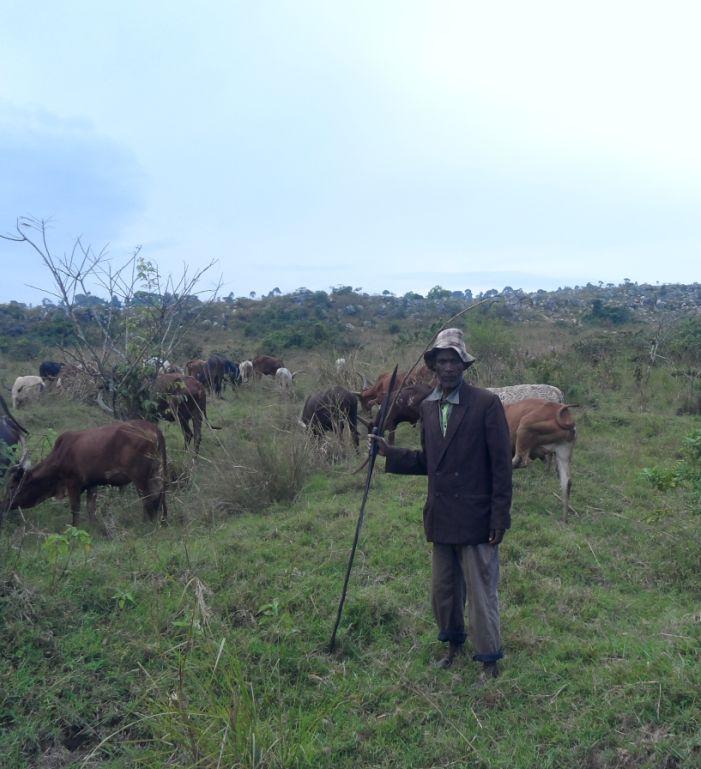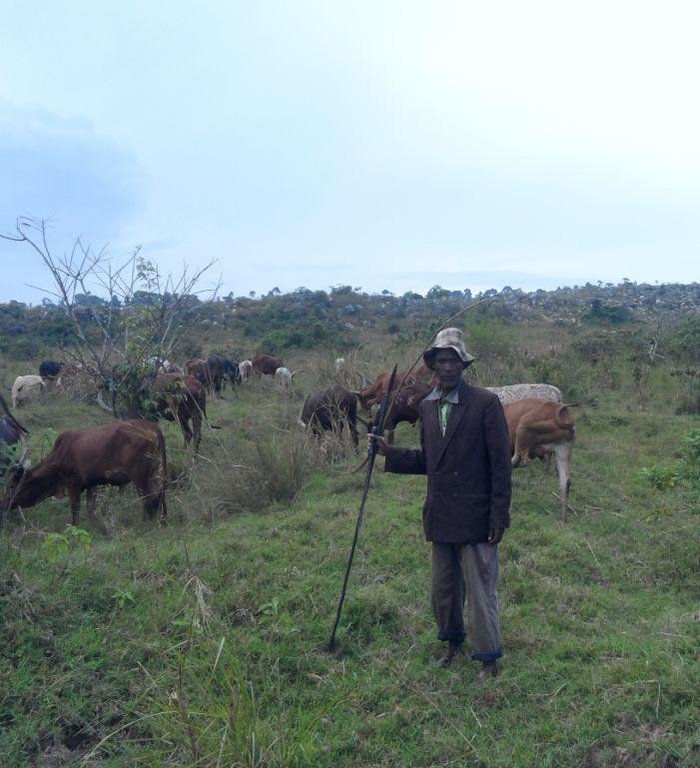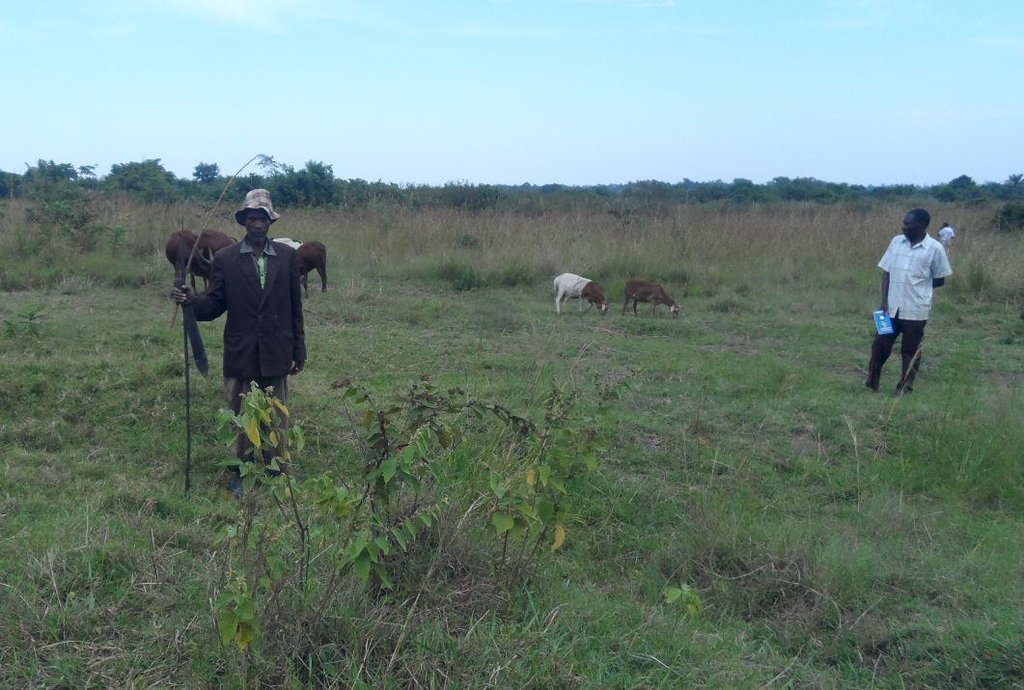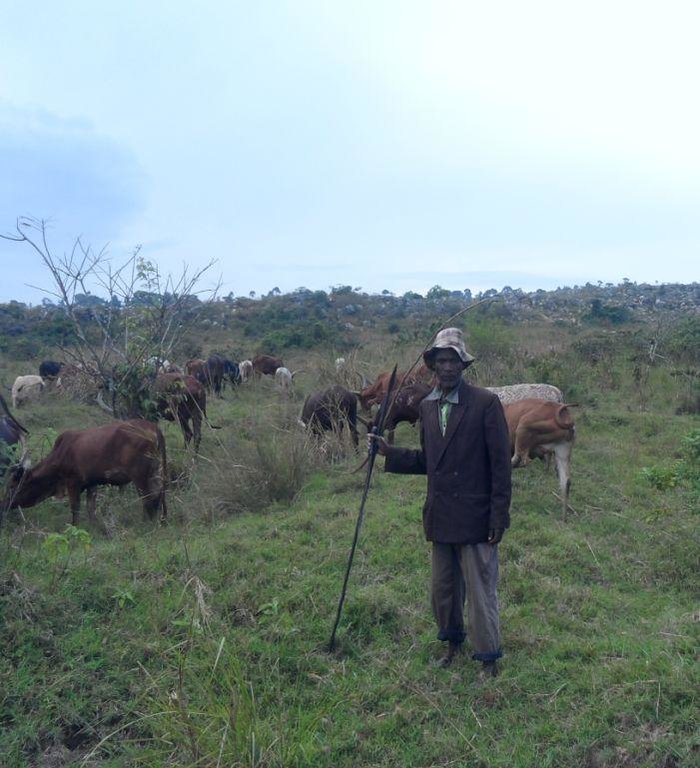Active participation of herder leader (WAKONDO) in management of grassland and riverine ecosystems [Tanzania, República Unida de]
- Creación:
- Actualización:
- Compilador: ALLAN BUBELWA
- Editor: –
- Revisor: Fabian Ottiger
Matumizi ya wamiliki wa mifugo (WAKONDO) katika hifadhi na matumizi bora ya nyanda za malisho na bionwai za mto.
approaches_2488 - Tanzania, República Unida de
Visualizar secciones
Expandir todo Colapsar todos1. Información general
1.2 Detalles de contacto de las personas de referencia e instituciones involucradas en la evaluación y la documentación del Enfoque
Especialista MST:
Especialista MST:
Egidius Pancras
Missenyi District Council
Tanzania, República Unida de
Nombre de la(s) institución(es) que facilitaron la documentación/ evaluación del Enfoque si fuera relevante)
Bukoba district council (Bukoba district council) - Tanzania, República Unida deNombre de la(s) institución(es) que facilitaron la documentación/ evaluación del Enfoque si fuera relevante)
Missenyi District Council (Missenyi District Council) - Tanzania, República Unida de1.3 Condiciones referidas al uso de datos documentados mediante WOCAT
¿Cuándo se compilaron los datos (en el campo)?
03/06/2014
El compilador y la/s persona(s) de referencia claves aceptan las condiciones acerca del uso de los datos documentados mediante WOCAT :
Sí
1.4 Referencia/s al/los Cuestionario(s) de Tecnologías MST
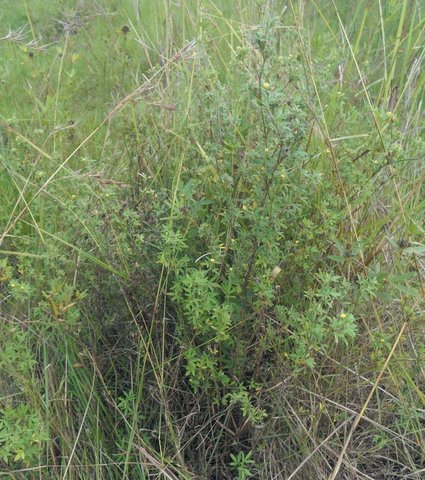
Area enclosures for protection of riverine ecosystem and … [Tanzania, República Unida de]
Area enclosures for protection of riverine ecosystem and purposeful regeneration of mulching and pasture materials for cut and carry
- Compilador: ALLAN BUBELWA
2. Descripción del Enfoque MST
2.1 Breve descripción del Enfoque
Prevention and mitigation of the grazing land and riverine ecosystems through mandatory grassroots meetings, law enforcement and active participation and empowerment of herder leaders’ (masters of the most resource destructive group)
2.2 Descripción detallada del Enfoque MST
Descripción detallada del Enfoque MST:
Aims / objectives: Aim/objectives: Empowering the village community, to take charge prevention and rehabilitation of the degraded and endangered grazing land and riverine ecosystem. Enhance SLM sustainability through agenda mainstreaming operationalization and formalization into existing information sharing and decision making forums. SLM be implemented through complementary and concerted efforts of the central government, local governments, grass roots institutions and the community at large. Community exposure to legal and policy framework guiding SLM and actively engaged in making informed decision.
Methods: Methods: The most resource destructive group is actively engaged and empowered to take the leading role in prevention and mitigation of the endangered and degrading riverine and grazing land ecosystems. SLM matters are formalized /operationalized and becomes permanent agenda in mandatory grassroots information sharing and decision making forums (sub village meetings, village assembly, ward development committee). The use of multi-sectorial concerted efforts that involves direct support by the central government in matters relating to SLM peace and tranquility (e.g. communities provided with mobile phone numbers for timely reporting of any destructive fire incidence and other environmental and peace threatening malpractices). Knowledge management and training (farmer capacity building) scaled up through adult learning methods (e.g. SLM demos). Active involvement of the most resource destructive group (herdsmen and their masters) in planning, implementation, monitoring and evaluation, decision making and bylaw formation and reinforcement. Herders who usually suffer rights to information (due to their tight daily activity clock) are informed, lead and guided by their masters.
Stages of implementation: Implementation starts with land degradation analysis and identification of the red spots (land degradation problems) to be addressed. Development of community SLM site specific action plan indicating the degradation type, proposed prevention and mitigation intervention methods, conservation methodology/approach to use, inputs needed, people /stakeholder involvement and time frame, stakeholder awareness raising plan, training, education and capacity building. Roles distribution, joint implementation, monitoring and evaluation of community action plan.
Role of stakeholders: Community: take charge of SLM activities (e.g. land demarcation, planting of tree, reseeding of pasture, e.t.c.), potential informer of malpractices and play a role of grass roots community guard, detectors of SLM crimes are also responsible for up keeping of public order.
Sub and village governments: formation of village environmental committees, taking leading role in inclusion of SLM agendas in mandatory sub village and village meetings, community mobilization and law enforcement.
WAKONDO: forms the core stakeholders in this approach (as experience shows that herders are the major source of uncontrolled fire burning and intruders of riverine ecosystems), participate in decision making and bylaw formation, guide and frequently remind and lead herders how and where to graze, interpreted bylaws to herders so that they make wise and informed decision and liaise herders with sub village and village government.
Environmental committee: law enforcers, environmental patrollers, direct involvement in SLM activities, awareness creation through various means e.g. use of posters.
District council: Awareness creetion, training, education and capacity building and interpreting to the community laws and policy guiding SLM.
Central government: SLM peace and tranquility and law enforcement.
Other important information: The basic principle underlying this approach is facing SLM through multi-sectorial collaboration and active participation of the most resource destructive group of the community. The average annual costs needed in running the approach is > 2000 USD.
2.3 Fotos del Enfoque
2.5 País/ región/ lugares donde el Enfoque fue aplicado
País:
Tanzania, República Unida de
Región/ Estado/ Provincia:
Tanzania/Kagera
Especifique más el lugar :
Missenyi/Kitobo/Kyazi
2.6 Fechas de inicio y conclusión del Enfoque
Indique año del inicio:
2012
Año de conclusión (si el Enfoque ya no se aplica):
2014
2.7 Tipo de Enfoque
- Local initiatives mixed in a comprementary maner with project project initiatives.
2.8 Propósitos/ objetivos principales del Enfoque
The Approach focused mainly on SLM with other activities
Empowering and involvement of the community by building confidence, ownership and capacity to take charge prevention and mitigation of the degraded and endangered grazing land and riverine ecosystem. Establishment of active and reliable environmental committee. Make SLM to be permanent agenda and formalized into existing information sharing and decision making forums.
SLM be implemented through complementary and concerted efforts of the central government, local governments, grass roots institutions and the community at large.
The SLM Approach addressed the following problems: Overgrazing and uncontrolled fire burning by herders, who undertake animal caring for WAKONDO (livestock owners), their activity clock is usually occupied and is under the control of their masters, they are voice less, no access to information about SLM, weak and have no power in decision making.
WAKONDO not adequately and effectively engaged in planning and implementing SML activities.
Dormant and inactive environmental committee coupled with lack of SLM technical knowledge.
No clearly defined grassroots forums for developing and dealing permanently with SLM agendas.
Weak, conflicting and disjointed efforts invested to environmental conservation.
2.9 Condiciones que facilitan o impiden la implementación de la/s Tecnología/s aplicadas bajo el Enfoque
normas y valores sociales/ culturales/ religiosos
- impiden
Poor grazing techniques characterized by overgrazing and uncontrolled fire burning.
Treatment through the SLM Approach: Active training and engagement of WAKONDO (cattle owners) in planning, implementation, monitoring, evaluation and SLM decision making.
disponibilidad/ acceso a recursos y servicios financieros
- impiden
Low quick financial realization by members of the village community who invest their valuable time in SLM (e.g. members of environmental committee)
Treatment through the SLM Approach: Introduce environmental based quick win project (QWP) and income generating activities (IGA).
entorno institucional
- impiden
Weak and ineffective commitment of the local governments at the grassroots level (sub village, village and ward).
Treatment through the SLM Approach: SLM be formalized as one of the permanent agenda in grassroots planning and decision making forums (mandatory village and sub village meetings).
marco de trabajo legal (tenencia de tierra, derechos de uso de tierra y agua)
- facilitan
The existing land ownership, land use rights / water rights moderately helped the approach implementation: The current bylaws contribute significantly in adherence to environmental conservation and approach objectives.
- impiden
Unlimited and uncoordinated use of grazing and riverine resources. Inadequate law enforcement. Low engagement of the central government (law enforcers and observers of peace and tranquility).
Treatment through the SLM Approach: Demarcation and encrosure of engendered grazing land and riverine ecosystems coupled with use of sign/warning posters. Active engagement of the central government (law enforcers and observers of peace and tranquility) e.g. community awareness and access to DCs phone for reporting crimes and any environmental threatening malpractices.
conocimiento de MST, acceso a apoyo técnico
- impiden
Unintended results in management of the grazing land ecosystem (e.g. emergency of invasive species)
Treatment through the SLM Approach: Research and find alternative use of the invasive species and mobilize for controlled and organized consumption.
carga de trabajo, disponibilidad de mano de obra
- impiden
High work load to members of village environmental committee.
Treatment through the SLM Approach: Development of regular time table and are the priority and potential beneficiaries of IGA.
3. Participación y roles de las partes interesadas involucradas
3.1 Partes interesadas involucradas en el Enfoque y sus roles
- usuarios locales de tierras/ comunidades locales
Community at large, Environmental groups/commitees, WAKONDO and herders. Individual local communities (youth, elders, male and females)
Farmer groups, environmental committees (males and females). Almost gender balanced environmental committee, active participation of the youth and indiscriminate participation of disabled (as a matter of fact the chairperson of environmental committee is an handicapped)
- especialistas MST/consejeros agrícolas
Site facilitators (all males), District SLM multidicipline team (femals and males) . District Planning Team
- gobierno local
District, Village and Sub village governmen, village leaders and ward community representatives (Councilors).
- gobierno nacional (planificadores, autoridades)
Central Government
- organización internacional
Transboundary Agroecosystem Project (TAMP)
3.2 Involucramiento de los usuarios locales de tierras/ comunidades locales en las distintas fases del Enfoque
| Involucramiento de los usuarios locales de tierras/ comunidades locales | Especifique quién se involucró y describa las actividades | |
|---|---|---|
| iniciación/ motivación | interactivo | Village council members and field experts - sensitization and awareness creation meetings. |
| planificación | interactivo | Village government, community and site facilitators - SLM planning meetings. |
| implementación | interactivo | Village government, community, groups and committees and site facilitators - Actual implementation of community site specific action plan. |
| monitoreo y evaluación | interactivo | Village government, community, groups and committees and site facilitators - Actual monitoring and evaluation of community site specific action plan. |
| Research | interactivo | Village government, community, groups and committees and site facilitators - client focused research to deal with undesirable and unintended results (e.g. on how to handle invasive species). |
3.4 La toma de decisiones en la selección de Tecnología(s) MST
Especifique quién decidió la selección de las Tecnología/ Tecnologías a implementarse:
- principalmente usuarios de tierras con el apoyo de especialistas MST
Explique:
Decision over the technology was a resultant of site characterization technically backstopped by SLM specialists and actively participated by the empowered and informed community.
Decisions on the method of implementing the SLM Technology were made by mainly by land users supported by SLM specialists. The method was the resultant of a process phases and steps dialogue, discussion and consensus attained between land user and SLM specialists.
4. Apoyo técnico, fortalecimiento institucional y gestión del conocimiento
4.1 Construcción de capacidades / capacitación
¿Se proporcionó la capacitación a usuarios de tierras/ otras partes interesadas?
Sí
Especifique quién fue capacitado:
- usuarios de tierras
- personal de campo/ consejeros
- leaders and politicians
Si fuese relevante, también especifique género, edad, estatus, etnicidad, etc.
all gender (male and female), all age (youth and elders), all status (the rich WAKONDO and the poor herders) and all ethnic group
Forma de capacitación:
- en el contexto de trabajo
- áreas de demostración
- reuniones públicas
Forma de capacitación:
- special and adhoc serminars
Temas avanzados:
Fire control, grazing management, forest management, pasture establishment and use of bylaws.
4.2 Servicio de asesoría
¿Los usuarios de tierras tienen acceso a un servicio de asesoría?
Sí
Especifique si servicio proporcionado se realizó:
- en los campos de los usuarios de tierras
Describa/ comentarios:
Name of method used for advisory service: Group method ; Key elements: Site vist and stakeholders visit, Group discussion, interaction and concensus building, local knowledge and technical knowledge balanced in a comprementary manner; Land users were visited by the experts and discussions held either on the site or elsewhere.
Advisory service is inadequate to ensure the continuation of land conservation activities; There is shortage of staff and the few staff have high workload/are given multiple tasks.
4.3 Fortalecimiento institucional (desarrollo institucional)
¿Se establecieron o fortalecieron instituciones mediante el Enfoque?
- sí, un poco
Especifique el nivel o los niveles en los que se fortalecieron o establecieron las instituciones:
- local
Especifique el tipo de apoyo:
- construcción de capacidades/ entrenamiento
Proporcione detalles adicionales:
Members of environmental committee were provided with various SLM trainings.
4.4 Monitoreo y evaluación
¿El monitoreo y la evaluación forman parte del Enfoque?
Sí
Comentarios:
bio-physical aspects were regular monitored by land users through observations; indicators: number of pasture growing species
technical aspects were regular monitored by project staff, land users through measurements; indicators: percentage increase in vergetation cover
socio-cultural aspects were ad hoc monitored by land users through observations; indicators: incedences of fire burning
economic / production aspects were regular monitored by land users through measurements; indicators: number of grass bundles harvested
area treated aspects were regular monitored by land users through measurements; indicators: % hacterage protected and harvested
no. of land users involved aspects were regular monitored by land users through measurements; indicators: number of adopters/participants
management of Approach aspects were regular monitored by land users through observations; indicators: Number of FFS, Demos and IGA, patrols meetings
There were several changes in the Approach as a result of monitoring and evaluation: arrangement for the community to find alternative uses of unintended products in pasture establishment (alternative use of invasive species) .
There were several changes in the Technology as a result of monitoring and evaluation: Monitoring and evaluation revealed the need to integrate SLM quick win project/IGA as stimulus factor to members of environmental committee who spend their valuable time in performing SLM activities.
5. Financiamiento y apoyo material externo
5.1 Presupuesto anual para el componente MST del Enfoque
Si no se conoce el presupuesto anual preciso, indique el rango:
- < 2,000
Comentarios (ej. fuentes principales de financiamiento/ donantes principales):
Approach costs were met by the following donors: international (Transboundary Agroecosystem project): 25.0%; government (Central Government ): 5.0%; local government (district, county, municipality, village etc) (Village government and District council ): 18.0%; local community / land user(s) (Community, groups, village invironmental commitees ): 52.0%
5.2 Apoyo financiero/material proporcionado a los usuarios de tierras
¿Los usuarios de tierras recibieron financiamiento/ apoyo material para implementar la Tecnología/ Tecnologías? :
Sí
5.3 Subsidios para insumos específicos (incluyendo mano de obra)
- agrícola
| Especifique qué insumos se subsidiaron | En qué grado | Especifique los subsidios |
|---|---|---|
| semillas | totalmente financiado | Pasture seed |
| fertilizantes | parcialmente financiado | DAP |
Si la mano de obra de usuarios de tierras fue un insumo sustancial, ¿fue:
- recompensado con otro tipo de apoyo material?
Comentarios:
the were rewarded indirectly through IGA and input provision
pasture seeds were supported fully but fertilizer was inadequate due to lean budget.
5.4 Crédito
¿Se proporcionó crédito bajo el Enfoque para actividades MST?
No
6. Análisis de impacto y comentarios de conclusión
6.1 Impactos del Enfoque
¿El Enfoque ayudó a los usuarios de tierras a implementar y mantener Tecnologías MST?
- No
- Sí, un poco
- Sí, moderadamente
- Sí, mucho
Improvement of vegetation cover through controlled fire burning, livelihood diversification through sell of mulching and pasture materials, protection of the grazing land and riverine ecosystem ensured through area enclosure, demarcation and controlled harvesting of mulching and pasture materials.
¿El Enfoque empoderó a grupos en desventaja social y económica?
- No
- Sí, un poco
- Sí, moderadamente
- Sí, mucho
Youth, women and the disabled interms of livelihood and income
Did other land users / projects adopt the Approach?
- No
- Sí, un poco
- Sí, moderadamente
- Sí, mucho
Did the Approach lead to improved livelihoods / human well-being?
- No
- Sí, un poco
- Sí, moderadamente
- Sí, mucho
additional income accrued through mulching and pasture materials to casual labour, transporters and farmers.
Did the Approach help to alleviate poverty?
- No
- Sí, un poco
- Sí, moderadamente
- Sí, mucho
Alternative income sources and improved money circulation.
6.2 Motivación principal del usuario de la tierra para implementar MST
- producción incrementada
expectation of getting high palatable pastures and mulching material for use and sale
- incremento de la renta(bilidad), proporción mejorada de costo-beneficio
Profit realized from improved animal and crop production arizing from use of pasture and mulch
- reglas y reglamentos (multas)/ aplicación
People worry purnishment in terms of pernaties and standing before the court of law.
- afiliación al movimiento/ proyecto/ grupo/ redes
Benefit from SLM projects in terms of IGA and easy access to extension services.
- conciencia medioambiental
Change of mindset through awareness creation and sensitization meetings/seminars.
- well-being and livelihoods improvement
dirvesification of income sources (income from the sell of mulching and pasture materials)
6.3 Sostenibilidad de las actividades del Enfoque
¿Pueden los usuarios de tierras sostener lo que se implementó mediante el Enfoque (sin apoyo externo)?
- sí
Si respondió que sí, describa cómo:
Because the approach is internationalized and formalized into the existing systems (e.g. SLM becomes permanent agenda in mandatory sub village and village meetings).
The use of goat loan IGA project where farmers are given goats on loan bases and pay goats which are then passed and spread to more of their fellow farmer can continue without support.
Involvement of central government e.g. access of district commissioners and divisional officers phone is a reliable SLM crime control mechanisms which does not require any of external support (a mere text message can save and protect abundant hectare of land).
6.4 Fortalezas/ ventajas del Enfoque
| Fuerzas/ ventajas/ oportunidades desde la perspectiva del usuario de la tierra |
|---|
| Improvement of the natural vegetation (How to sustain/ enhance this strength: To continue community education ) |
| Availability of mulching materials (How to sustain/ enhance this strength: Controlled harvesting and fire prevention ) |
| Availability of fuel wood (How to sustain/ enhance this strength: Permanent and routine guard ) |
| Fuerzas/ ventajas/ oportunidades desde la perspectiva del compilador o de otra persona de referencia clave |
|---|
| Incorporation internalization of SLM as permanent agenda in reliable mandatory grassroots forums (sub village and village meetings) (How to sustain/ enhance this strength: Continue internalization and SLM promotion through use of existing forums.) |
| Involvement of the central government (a mere text message can save and rescue abundance of hectare). (How to sustain/ enhance this strength: Continue use of the central government.) |
| Empowerment and active participation of the the most resource destructive and environmental threatening group (livestock keepers). (How to sustain/ enhance this strength: Continue use of WAKONDO (livestock owners) in planning, implementation and deciding SLM activities. ) |
| Use of self spreading IGA to motivate environmental committee members who spend their valuable time in SLM activities (e.g. goat loan projects). (How to sustain/ enhance this strength: Continue promotion, expansion and sustaining of self spreading IGAs.) |
| Dialogue and communication takes into consideration the daily activity clock of the stakeholder (through this principle WAKONDO can deliver SLM messages to herdsmen rather than SLM specialist) (How to sustain/ enhance this strength: Daily activity clock continue to be a criteria for planning SLM dialogue and communication.) |
6.5 Debilidades/ desventajas del Enfoque y formas de sobreponerse a ellos
| Debilidades/ desventajas/ riesgos desde la perspectiva del usuario de la tierra | ¿Cómo sobreponerse a ellas? |
|---|---|
| shortage of working gears (umbrella, gumboots, raincoats and stationary) | Ensure availability of working gears (e.g. SLM penalties be used to cover the costs of working gears). |
| Inadequate fund to support IGA | Commit adequate fund to support and expand IGA. |
| Violation of rules and procedures by some untrustworthy individuals | Strengthen law enforcement (use of penalties, court and ward tribunals) |
| No reliable transport for village environmental committees. | Ensure reliable transport for the village environmental committee. |
| Debilidades/ desventajas/ riesgos desde la perspectiva del compilador o de otra persona de referencia clave | ¿Cómo sobreponerse a ellas? |
|---|---|
| Existence of untrained-able and lazy herdsmen and less committed WAKONDO. | Strengthen law enforcement (e.g. use of penalties) |
| No reliable forum to collaborate with supplier of inputs and research as a results failure to figure out the reasons for unintended results (for this case unpalatable alien/native species overshadowed the palatable pasture and the reasons were not known) | Strengthen collaborations with Research and supplier of inputs (pasture seeds e.t.c.). |
7. Referencias y vínculos
7.1 Métodos/ fuentes de información
- visitas de campo, encuestas de campo
- entrevistas con usuarios de tierras
7.2 Referencias a publicaciones disponibles
Título, autor, año, ISBN:
A report on Kyazi Microcatchment Characteriaztion
Vínculos y módulos
Expandir todo Colapsar todosVínculos

Area enclosures for protection of riverine ecosystem and … [Tanzania, República Unida de]
Area enclosures for protection of riverine ecosystem and purposeful regeneration of mulching and pasture materials for cut and carry
- Compilador: ALLAN BUBELWA
Módulos
No se hallaron módulos


